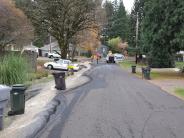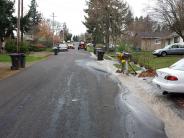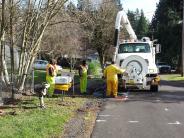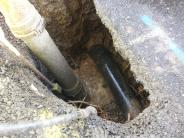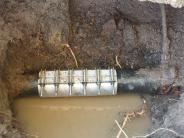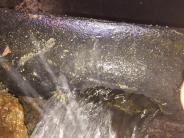Teamwork in Public Works
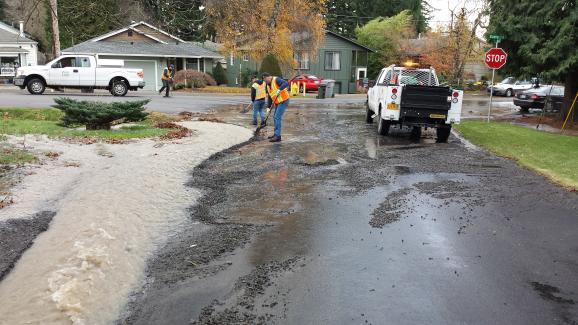
Divisions work together in response to water main break
JAN. 2, 2015 — The crews in West Linn Public Works are used to working together. With 16 employees providing daily service to more than 25,000 residents for streets, water, storm and sewer, they have to.
This team approach was put to the test Dec. 3 in the 2500 block of Cambridge Street when they had to act quickly and work together during a water main break. The result of that teamwork was saving not only a newly paved street, but time and taxpayers’ money.
A water main break was reported around 11 a.m. that day. When a break happens, damage to streets and homes can happen quickly as the water gushes from the break in the pipe. Water pours down the street, taking dirt, landscaping and whatever else is in its way with it. Soon storm basins can get clogged by the debris and the street can overflow. When that happens, it means it is often going onto someone’s property, in their garages and, in worst-case scenarios, into people’s homes.
According to Transportation Supervisor Jeff Randall, Public Works’ first priority in these cases is to protect property and ensure safety. It is important to get the water turned off quickly and control the flow of the water.
“Most people don’t know how much water comes out of a pipe (during a break)”
On Dec. 3, as luck would have it, Caldwell just happened across the scene of the fresh water main break and stopped to lend a hand and call in for reinforcements.
Since Cambridge Street was just paved in 2013, crews used a vactor truck (described by Cardwell as a giant vacuum cleaner on wheels) to suck the dirt and material out from under the street to gain access to the pipe and locate the break. Without the use of the vactor truck, the crew would otherwise tear up the street with a backhoe to access the break — a costly process in time and money.
While that work was happening, the transportation crew “chased” the water down the street, clearing the catch basins and containing the water.
In all, 16 homes were affected by the break and were without water for just a few hours thanks to the teamwork of the Public Works crews. Water and service was restored by 2:15 p.m.
The break was in a 6-inch cast iron pipe, installed in 1955. According to Water Operations Supervisor Jim Whynot, the pipe was corroded due to poor pipe bedding/backfill and inferior materials.
From the time the break happened to when cleanup was finished, it took 38 man-hours to address the break, split between three divisions of the Public Works Department — streets, environmental and water.
“We’re always helping each other out,” said Randall. “Everyone knows what their role is. We are such small crews, we have to be efficient to be this effective at getting the work done.”
Cross-training between crews has proven to be beneficial in Public Works. They train each other so when emergencies happen or storms hit, they all can respond quickly. Which is a good thing as the city’s water infrastructure is aging and more water main breaks are expected in the future. In fact, three more breaks occurred the following week, though not as large as the one on Cambridge.
“They come in waves,” Whynot said of the breaks, explaining that when the ground is saturated it weighs down on the pipes, which can lead to breaks.
Any advice from Public Works to West Linn residents? You bet! Know where your water shutoff valve is in your home. And, if you don’t have one, get one installed and learn how to use it. And, be sure to turn off your irrigation systems and pond pumps during cold snaps.

